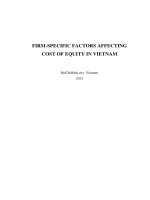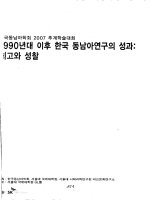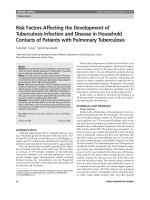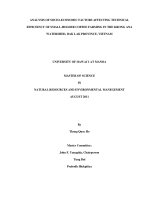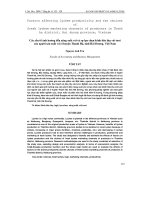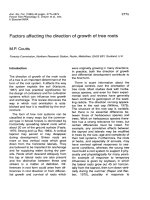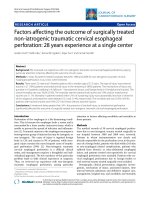Factors affecting work motivation of employees at operations division of fe credit finance limited company
Bạn đang xem bản rút gọn của tài liệu. Xem và tải ngay bản đầy đủ của tài liệu tại đây (1.72 MB, 96 trang )
RESEARCH PROJECT
(BMBR5103)
FACTORS AFFECTING WORK MOTIVATION OF
EMPLOYEES AT OPERATIONS DIVISION OF FE CREDIT
FINANCE LIMITED COMPANY
STUDENT’S FULL NAME
STUDENT ID
INTAKE
ADVISOR’S NAME & TITLE
: HONG VAN ANH
: CGS000064966
: MARCH 2016
: DR. BUI PHI HUNG
August 2017
Advisor’s assessment
..................................................................................................................................
..................................................................................................................................
..................................................................................................................................
..................................................................................................................................
..................................................................................................................................
..................................................................................................................................
..................................................................................................................................
..................................................................................................................................
..................................................................................................................................
..................................................................................................................................
..................................................................................................................................
..................................................................................................................................
..................................................................................................................................
..................................................................................................................................
..................................................................................................................................
..................................................................................................................................
..................................................................................................................................
..................................................................................................................................
..................................................................................................................................
..................................................................................................................................
..................................................................................................................................
Advisor’s signature
ACKNOWLEDGEMENTS
I assure the project "Factors affecting work motivation of employees at Operations
Division of FE CREDIT Finance Limited Company" is my own research.
The data and content presented in this project is completely valid and comply with
regulations on protection of intellectual property rights.
The research results presented in this project are not reproduced of any dissertation
and have not been presented or published in any other study before.
I take full responsibility for my research topic.
Ho Chi Minh City, Aug 6th 2017
Author of project
Hong Van Anh
3
THANK-YOU
First, I would like to sincerely thank the teachers of Hutech and Open University
Malaysia for teaching and imparting to me the precious knowledge that underlies
the implementation of this project.
Second, I would like to thank my instructor Dr. Bui Phi Hung who has guided me
through the writing process, taken the time to read and comment my drafts and
shared his knowledge within the research field.
Finally, I would like to thank all the interviewees for answering all my questions,
my dear colleagues for all the sound advices and my beloved family for always
listening and supporting me.
Many thanks to you all!
4
Table of Contents
Acknowledgements ................................................................................................ 3
Thank-you .............................................................................................................. 4
List of charts ........................................................................................................... 7
List of tables ........................................................................................................... 8
Abstract .................................................................................................................. 9
Charter 1. Introduction ......................................................................................... 10
1.1 Background .................................................................................................... 10
1.2 Problem statement .......................................................................................... 10
1.3 Purpose of the study ....................................................................................... 11
1.4 Contribution of the study ............................................................................... 11
1.5 Objective and scope of the study ................................................................... 12
1.6 Research method ............................................................................................ 12
1.7 Limitations of the study ................................................................................. 12
1.8 Dissertation structure overview ..................................................................... 13
Charter 2. Literature review and general study .................................................... 13
2.1 Definition of work motivation ....................................................................... 13
2.2 Theory on work motivation ............................................................................ 14
2.3 General study ................................................................................................. 22
2.4 Research model .............................................................................................. 26
2.5 Components and hypothesis ........................................................................... 27
Charter 3. Company background and research methodology .............................. 29
3.1 FE CREDIT in brief ....................................................................................... 29
3.2 Research methodology ................................................................................... 40
Charter 4. Research result and discussion ............................................................ 49
4.1 Sample descriptives ........................................................................................ 49
4.2 Cronbach’s Alpha coefficient analysis .......................................................... 51
4.3 EFA analysis .................................................................................................. 51
5
4.4 Regression analysis ........................................................................................ 55
4.5 Statistics descriptives ..................................................................................... 56
Charter 5. Conclusion and recommendation ........................................................ 59
5.1 Findings .......................................................................................................... 59
5.2 Recommendations .......................................................................................... 60
5.3 Further research directions ............................................................................. 65
References ............................................................................................................ 66
Appendix .............................................................................................................. 69
6
List of charts
Chart 2.1: Maslow’s hierarchy of needs .............................................................. 16
Chart 2.2: Herzberg two-factor theory ................................................................. 17
Chart 2.3: Alderfer’s ERG theory ........................................................................ 19
Chart 2.4: McGregor’s theory X and theory Y .................................................... 20
Chart 2.5: McClelland’s acquired needs .............................................................. 21
Chart 2.8: Proposed research model .................................................................... 27
Chart 3.1: Organizational structure of FE CREDIT ............................................ 35
Chart 3.2: Business structure of FE CREDIT ...................................................... 36
Chart 3.3: Hierarchy of management ................................................................... 37
Chart 3.4: Organizational structure of Operations Division ................................ 39
Chart 3.5: Research process (source: the author) ................................................. 40
7
List of tables
Table 2.6: Article or review published on motivation ......................................... 24
Table 2.7: Motivation dimensions ....................................................................... 26
Table 3.6: Scale and observational variables ....................................................... 45
Table 4.1: Survey structure .................................................................................. 50
Table 4.2: KMO measure ..................................................................................... 52
Table 4.3: Rotated component matrix .................................................................. 54
Table 4.4: Model summary .................................................................................. 55
Table 4.5: Regression ........................................................................................... 56
Table 4.6: Descriptive Statistics ........................................................................... 57
8
Abstract
Research on motivation has attracted academic and corporate entities over the last
two decades. Motivation directly links to individual performance that gain to
organization performance and as a catalyzer for all individual employees working
for an organization to enhance their working performance or to complete task in
much better way than they usually do. This research on work motivation was
conducted in 2017, with a sample size of 200 employees who are working at the
Operations Division of Finance Limited Company FE CREDIT.
The research model included seven independent variables: Base salary; Training
and promotion; Relationship towards leaders; Relationship towards co-workers;
Working conditions; Work itself; Benefits and reward.
The study has identified seven factors that affect the work motivation of employees.
The study also found there are differences in perception and evaluation of factors
affecting work motivation of different groups of employees.
9
CHARTER 1 – INTRODUCTION
1.1. Background
The process of globalization and international economic integration has been
happening fast and drastically and became the trend of development of the world
economy. In that context, economic development is one of the top strategies and
people are an indispensable resource and play a very important role in that
development.
To increase human productivity in the organization, the work motivation is very
important. Any organization would like its employees to fulfill their work with high
efficiency to contribute to the successful accomplishment of their goals. However,
in the team there are always enthusiastic employees with high performance results
but there are also ones who are working in sluggishness, lack of interest,
indifference to work, even not fulfilling their assigned tasks which lead to low
performance results. The economists have pointed out the answer to that problem is
the work motivation of every individual employee. The motivation to work is
considered as a strong lever which motivates the employees to work actively,
thereby contribute to improve the efficiency of business production of the company.
1.2. Problem statement
Nowadays, with the rapid development of consumer credit trends in Vietnam, the
human resources of finance companies have rapidly increased in recent years.
However, the inspiration and motivation for these employees are not as good as the
leaders’ expectation. There is still a large majority of employees who are passive
and have not achieved good results in their assigned work. Especially, towards FE
CREDIT, currently the market leader in finance industry, with the rapidly
expanding human resources and the increasingly intense competition from
competitors, pushing motivation for employees is more important than ever.
Facing the situation of limitations in creating work motivations at FE CREDIT,
especially FE CREDIT's Operations Division which is one of the key blocks of the
10
company, the “delay” mindset of employees hasn’t been improved while the quality
of work hasn’t been met, this research is conducted to find out the factors that affect
the work motivation and how to encourage employees to feel motivated with their
job at work. Thereby, this research will suggest the Company how to maintain the
work motivation of employees and develop these human resources.
The questions that need to be solved in the research are:
1. What are the factors that affect the motivation of the employees in
Operations Division of FE CREDIT?
2. What is the impact of each factor?
3. How to improve the motivation of employees when these factors are
identified?
1.3 Purpose of the study
+ Identify the factors that significantly affect the motivation of employees at the
Operations Division of FE CREDIT Finance Limited Company.
+ Quantify the impact of these factors on the motivation of employees at the
Operations Division of FE CREDIT Finance Limited Company.
+ Apply theory into assessing the company situation of work motivation and
propose solutions to boost the motivation of employees at the Operations Division
of FE CREDIT Finance Limited Company.
1.4. Contribution of the study
This research was carried out for the purposes of understanding and assessing the
situation of work motivation among the employees at Operations Division - FE
CREDIT Finance Limited Company, as well as identifying the factors that affects
this motivation. This research also provides FE CREDIT the insights of factors that
bring the motivation to employees. From there, they will have the appropriate
orientation and policies in using labor in the most effective way in order to create
11
the expected labor output of the manager and associate employees with long-term
dedication to the Company.
1.5. Objective and scope of the study
- Place: at Operations Division of FE CREDIT Finance Limited Company.
- Objective:
+ Research on work motivation factors only at head office of Operations Division
of FE CREDIT Finance Limited Company (do not research at representative office
or under-direct center)
+ Suggest solutions
1.6 Research method
This study uses qualitative and quantitative methods for analysis. While the
qualitative analysis was conducted on the basis of motivation theories to construct
factors influencing motivation of employees based on linear regression analysis, the
quantitative method was implemented through the application of econometric
regression models to assess the impact of factors on employee motivation.
Statistical analysis of survey data is done by SPSS software version 16.0.
+ Source of data:
- Secondary data is collected from statistics and reports from the departments of
Operations Division of the Company.
- Primary data is collected through a sociological survey using questionnaires for
current employees at the Division.
+ Time frame of the survey: from May 2017 to June 2017.
1.7. Limitations of the study
Firstly, due to limited research time, the author has not been able to carry out indepth interviews after quantitative research to find out the "inside" information, the
deeper nature of the research conclusions.
12
Second, the empirical method of sampling, non-probability, may not fully evaluate
the measurement error. Consequently, the conclusions may have certain limitations.
Third, the research is carried out in a short time so there is not much basis to
evaluate changing trends in research.
1.8. Dissertation structure overview
Besides the opening and the conclusion, this dissertation includes structure as
below:
Charter 1: Introduction
Charter 2: Literature review and general study
Charter 3: Company background and research method
Charter 4: Research results and discussion
Charter 5: Conclusion and recommendation
In general, Chapter 1 shows the introduction to the reason of research, research
objectives, and scope of research and practical meaning of the research. Follows is
the Chapter 2 which will present the theoretical basis, the theoretical models have
been studied before in order to suggest research models and model hypotheses.
CHARTER 2 – LITERATURE REVIEW AND GENERAL STUDY
2.1. Definition of work motivation
Motivating employees seems like it should be easy. And it is - in theory. But while
the concept of motivation may be straightforward, motivating employees in real-life
situations is far more challenging. In fact, there are many different perspectives on
work motivation. According to Maehr and Meyer, "Motivation is a word that is part
of the popular culture as few other psychological concepts are." Motivation is the
reason for people's actions, desires, and needs. Motivation is also one's direction to
behavior, or what causes a person to want to repeat a behavior. A motive is what
prompts the person to act in a certain way, or at least develop an inclination for
13
specific behavior. And work motivation "is a set of energetic forces that originate
both within as well as beyond an individual's being, to initiate work-related
behavior, and to determine its form, direction, intensity, and duration" according to
Pinder, C.C. (2008).
It is important for organizations to understand and to structure the work
environment to encourage productive behaviors and discourage those that are
unproductive given work motivation's role in influencing workplace behavior and
performance.
2.2. Theory on work motivation
The issue of motivation and reward to satisfy the need that help employees stick
with the business for long term is a matter that attracts the attention of many
executives as well as researchers. So far, there have been a lot of research doctrines
on how to motivate employees.
For example, the classic theory of motivation was stated by F.W. Taylor (1915) that
in order to motivate the employees, the managers must find the best way to teach
them work, and use economic incentives such as wages and bonuses to motivate
them. Abraham Maslow (1943) argued that managers have to understand the needs
of employees and find ways to satisfy those. The needs are arranged from low to
high, including: survival; security; belonging; importance and self-actualization.
According to Douglas McGregor (1956), his human nature theory points out that up
to the nature of X (the people who are lazy at work and do not like to work...) or the
nature of Y (the people who like to work and are self-conscious...) of employees to
apply the encouraging measures. While the theory of Maslow and McGregor was
built on the basis of psychological theory, the theory of Herzberg (1976) was built
on the basis of practical knowledge of employees. Besides, there are also many
other modern theories of motivating employees such as the theory of expectancy,
the theory of justice, etc.
14
This research will study only on some typical motivational theories such as the
Maslow ladder; Theory X, Y; Herzberg two-factor theory; ERG theory and
McClelland theory. Through these theories, managers can draw the appropriate
incentives to achieve expected behavior among employees.
2.2.1. Maslow’s Hierarchy Of Needs (1943)
It can be said that Maslow's theory of human needs is the dominant theory in the
theory of behavior.
Abraham Maslow (1908-1970) - American psychologist believes that human beings
have five needs in a hierarchy from low to high as follows:
- Physiological needs: eating, resting, sewing, sex ... (Survival)
- The need for safety: body, life, health, work, property ... (Security)
- Social needs: engagement, sharing, cooperation, club membership, party ...
(Belonging)
- Recognization demand: remuneration, reward, promotion, reputation, award ...
(Importance)
- The need for self-improvement: knowledge, skills, thinking, want to perfect,
develop personality, creativity ... (Self Actualization)
Five needs are divided into two levels of high and low rank:
- High demand: internal impact, including self-assertion and self-esteem
- Low demand: external impact, social needs, safety needs and material needs
15
Chart 2.1: Maslow’s hierarchy of needs
Accordingly, low-level needs will normally be met prior to the emergence of
higher-level needs. However, sometimes, these needs may still arise out of
sequence.
People always have unmet needs, and these needs motivate them to act to satisfy
them. Organizations need to recognize the needs of human resources and skillfully
use impact measures to make them enthusiastic and dedicated to their work.
Humans are motivated to reach higher demands after low-level needs such as
physiological needs and safety needs are met. This was Maslow's call for increased
satisfaction. This theory draws one thing: managers who want to motivate anyone
need to know what they are on the demand ladder and find ways to satisfy or exceed
this demand.
16
2.2.2. Herzberg's Two-Factor Theory (1959)
Frederick Herzberg, the American management theorist, divides motivational
factors into two groups: the retention factor (external satisfaction) and the
motivational factor (satisfying intrinsic nature).
Chart 2.2: Herzberg two-factor theory
The first group (including wages, supervisory management and working conditions)
only works to maintain normal working status. When these factors are satisfied,
sometimes employees consider it natural. But without them, they will become
dissatisfied and performance will decrease.
The second group (which includes success, promotion, development, challenges and
accountability) are really motivating factors.
Without the motivational elements, employees will express unhappiness,
unhappiness and laziness. This causes mental instability. According to Herzberg,
17
instead of trying to improve retention factors, managers should increase
motivational factors if motivated by motivation.
He argues that a person's personal relationship to work is a fundamental and joboriented attitude that can determine the success or failure of the individual.
According to this doctrine, internal factors related to job satisfaction and external
factors lead to dissatisfaction.
This theory helps managers to identify factors that cause dissatisfaction among
employees and thereby seek to eliminate these factors. For example, employees
may be dissatisfied with their work because their wages are too low, superiors are
over-supervised, and relationships with co-workers are not good. So managers must
find ways to improve salaries, reduce supervision, and build better co-workers.
However, when disgruntled factors are eliminated, it does not mean that employees
will be satisfied. If the company wants to motivate employees, make them happy at
work, the manager needs to focus on factors such as success, perception, job itself,
responsibility and development. For example, employees will feel satisfied with
their work when they are given the right job and their personality, have the
opportunity to study and improve their professional skills.
2.2.3. Alderfer's ERG Theory (1969)
This theory was proposed by the scholar of organizational behavior Clayton
Alderfer to overcome the problems encountered in Maslow's theory. He conducted
a review of Maslow's research. He also said that human action is rooted in demand;
there are three types of demand as follows:
1. Exists demand: including physiological needs and safety needs.
2. Relationship demand: the need for interpersonal relationships, the need for social
relationships.
3. Development demand: the need for self-expression and self-esteem.
18
Chart 2.3: Alderfer’s ERG theory
He argues that humans are at the same time pursuing all their needs, not just one, as
Maslow said. Moreover, when a need is hindered they will put their efforts to
another need.
Unlike Maslow's model, ERG theory refers to the process of regressing failure. This
process assumes that when we cannot satisfy the higher demand, we will return to
lower demand levels. As for Maslow, people are still at the level of desire and
seeking ways to satisfy this need. ERG theory is actually used by managers in the
form of employee salaries. This means that wages will increase according to the
number of employees' skills acquired or the number of jobs completed. This form
encourages employees to study, improve their skills and develop their career.
2.2.4. Douglas McGregor's X-Y Theory
Douglas McGregor gives two contradictory views about humans:
19
- Theory X assumes that employees do not like to work, lazy, do not like to be
responsible and must be forced to do the job.
- Theory Y assumes that employees love to work, be creative, responsible and able
to work on their own.
Chart 2.4: McGregor’s theory X and theory Y
What can be applied from this doctrine? To answer the question, we need to use
Maslow's demand ladder theory. The doctrine of X speaks of individuals who are at
a lower level of demand, while the hypothetical doctrine of personal preference is in
high demand. McGregor believes that the Y theory is more effective than the X
theory. Thus, he offers the same ideas for employees involved in decision making,
designing responsible and challenging jobs, building a good teamwork relationship
that motivates employees to the maximum.
2.2.5. McClelland Achievement Theory (1988)
This theory focuses on three needs: achievement, power and affiliation.
20
Demand for achievement: A person with a performance need is eager to accomplish
challenging goals with his or her own effort, to succeed in the competition, and to
receive feedback about the results of their work in a clear way.
Demand for power: people with the desire for power want to influence, influence
and control resources, and control people if they are beneficial to them.
Demand for affiliation: Desire to have a close and friendly relationship with the
people around, make people try for friendship, like cooperation rather than
competition, the desire to build relationships based on the spirit of mutual
understanding.
Chart 2.5: McClelland’s acquired needs
Applied in practice, one can realize that individuals with high achievement needs
will succeed in corporate operations. But having high achievement needs does not
necessarily become a good manager, especially in large organizations. Since they
21
are only interested to personally make good without affecting others so they also
work well. Meanwhile, the need for power and coalition is closely related to
management success. Managers work best when there is demand for high power
and low coalition demands.
Another conclusion drawn from this theory is that the need for achievement can be
encouraged through training. Therefore, organizations can organize training
programs to promote the strength of these needs. For example, employees may be
trained in ways to think for high performance at work, know how to win, know how
to respond to situations ... Training programs of this type are usually for employees.
They are doing jobs that require the development of high achievement requirements
such as sales. In fact, theories X, Y; The two-factor theory; McClelland’s theory of
demand is also used by managers in employee involvement programs. This program
aims to make the most of the employees' capabilities and encourage them to stick
with the organization for a long time. In particular, let them participate in the
management process of the organization, appoint their representatives to join the
decision-making group in the company or participate in the process of quality
management, share the employees. For theory X, Y, this program emphasizes that
employees are interested in working, responsible and self-directed, thus requiring
them to be involved in the management process. For the two-factor theory, the
involvement of employees in management and decision-making is an internal
motivational factor that helps them develop, feels responsible. At the same time,
this program also aims to satisfy the needs of employees such as performance
needs, respect, recognition and development.
2.3. General study on work motivation
Panagiotakopoulos (2013) concluded that factors affecting staff motivation at a
period where the financial rewards are kept to the least leads to stimulate employee
performance. So, management personnel’s responsibility to motivate their
employees to work as per the expectation to enhance the organization’s
22
performance. Similarly Dysvik and Kuvaas (2010) concluded that intrinsic
motivation was the strongest predictor of turnover intention and relationship
between mastery-approach goals and turnover intention was only positive for
employees, low in intrinsic motivation. The only thing organization needs to do is
to give employees with ample resources and platform to do.
As per Kuo (2013) a successful organization must combine the strengths and
motivations of internal employees and respond to external changes and demands
promptly to show the organization’s value. Barney and Steven Elias (2010) found
that with extrinsic motivation there exist a significant interaction between job stress,
flex time, and country of residence. Leaders know that at the heart of every
productive and successful business lies a thriving organizational culture and
hardworking people collaborate passionately to produce great results (Gignac and
Palmer 2011).
Likewise, Malina and Selto (2001) conducted a case study in one corporate setting
by using balance score card (BSC) method and found out that organizational
outcomes would be greater if employees are provided with positive motivation.
Aguinis et al. (2013) stated that monetary rewards can be a very powerful
determinant of employee motivation and achievement which, in turn, can advance
to important returns in terms of firm-level performance. Garg and Rastogi (2006)
identified the key issues of job design research and practice to motivate employees’
performance and concluded that a dynamic managerial learning framework is
required to enhance employees’ performance to meet global challenges.
Vuori and Okkonen (2012) stated that motivation helps to share knowledge through
an intra-organizational social media platform which can help the organization to
reach its goals and objectives.
As summarized by Park (2010), monetary incentive acts as a stimulus for greater
action and inculcates zeal and enthusiasm toward work; it helps an employee in
recognition of achievement. Likewise, Beretti et al. (2013) discussed that monetary
23
incentives used to build a positive environment and maintain a job interest, which is
consistent among the employee and offer a spur or zeal in the employees for better
performance.
Year
No. of article or review
published on motivation
1,549
1,554
1,603
1,685
2,027
2,064
2,794
2,994
3,041
3,187
3,412
3,580
3,995
4,643
5,125
5,878
6,429
6,943
7,585
8,501
9,173
9,861
10,679
6,858
% increase in
publication
—
0.322
3.15
5.11
20.29
1.82
35.36
7.15
1.56
4.8
7.05
4.92
11.59
16.22
10.38
14.63
9.37
7.99
9.24
12.07
7.9
7.5
8.29
Still continuing
1990
1991
1992
1993
1994
1995
1996
1997
1998
1999
2000
2001
2002
2003
2004
2005
2006
2007
2008
2009
2010
2011
2012
2013a
A Current year and
it’s still continuing
publication
Table 2.6: Article or review published on motivation
24
Sl. no.
Dimension
Author(s)
No. of
citation
25
1
Training
Commeiras et al. (2013);
Panagiotakopoulos (2013); Williams
(2013); Lazazzara and Bombelli
(2011); Gegenfurtner et al. (2009);
Gegenfurtner et al. (2009); Noe (2009);
Rowold (2007); Bell and Ford (2007);
Klein et al. (2006); Tai (2006);
Chiaburu and Tekleab (2005);
Kontoghiorghes (2004); Tsai and Tai
(2003); Tharenou (2001); Kirkpatrick
(2000);Colquitt et al.(2000); Seyler et
al. (1998); Kirkpatrick (1996); Facteau
et al.(1995); Cannon-Bowers et al.
(1995); Whitehill and McDonald
(1993); Clark et al. (1993); Mathieu et
al. (1992); Baldwin et al. (1991).
2
Monetary
incentives
Beretti et al. (2013);
Panagiotakopoulos (2013); Aguinis et
al. (2013); Szczepanowski et al. (2013);
Schultz and Brabender (2013);
Pouliakas (2010); Feldman and Lobel
(2010); Park (2010); Jain et al. (2007);
Rose et al. (2007); Zhang and Wu
(2004); Linder (1998); Leung et al.
(1996); Nelson (1996); Rowley
(1996a, b); Kovach (1995).
16
3
Job transfer
Azizi and Liang (2013); Swift and
Hwang (2013); Asensio-Cuesta et al.
(2012); Casad (2012); Datta and
Eriksson (2012); Eguchi (2004); Zhang
and Wu (2004); Cosgel and Miceli
(1999); Cheng and Brown (1998);
Ichniowski et al. (1997).
10
4
Job satisfaction
Pantouvakis and Bouranta (2013);
Pravin and Kabir (2011);
Wickramasinghe (2009); Kaliski
(2007); Saari and Judge (2004);
Williams et al. (2003); Bussing et al.
(1999); George and Jones (1997).
8
25
